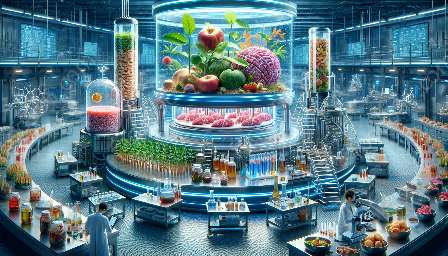Anaerobic digestion is a biological process that occurs when organic matter is broken down by microorganisms in the absence of oxygen. This process is an integral part of waste-to-energy conversion in the food processing industry through biotechnology, and is closely linked to food biotechnology.
Understanding Anaerobic Digestion
What is Anaerobic Digestion?
Anaerobic digestion is a natural biological process that involves the breakdown of organic matter, such as food waste and agricultural residues, by microorganisms in the absence of oxygen. This process produces biogas, a renewable energy source, and a nutrient-rich digestate that can be used as a biofertilizer.
Key Stages of Anaerobic Digestion
The process of anaerobic digestion can be divided into four key stages: hydrolysis, acidogenesis, acetogenesis, and methanogenesis. During these stages, different groups of microorganisms work together to break down complex organic compounds into simpler molecules and eventually produce biogas.
The Role of Anaerobic Digestion in Waste-to-Energy Conversion
Utilizing Biogas for Energy Production
One of the significant applications of anaerobic digestion is the production of biogas. Biogas is primarily composed of methane and carbon dioxide, making it a valuable renewable energy source. In the food processing industry, biogas produced through anaerobic digestion can be utilized as a substitute for conventional fossil fuels, contributing to waste-to-energy conversion and reducing greenhouse gas emissions.
Reduction of Organic Waste
Through anaerobic digestion, organic waste from food processing facilities can be efficiently converted into biogas and digestate. This process allows for the effective management of organic waste, reducing the environmental impact of waste disposal and contributing to the sustainable utilization of resources in the food industry.
Integration of Food Biotechnology
Enhancing Digestion Efficiency through Biotechnological Methods
Food biotechnology plays a crucial role in enhancing the efficiency of anaerobic digestion processes. Biotechnological methods, such as microbial augmentation and genetic engineering of microorganisms, can optimize the performance of anaerobic digesters by promoting the activity of specific microbial consortia and improving the degradation of complex organic compounds.
Biogas Upgrading and Utilization
Food biotechnology also contributes to the upgrading and utilization of biogas obtained from anaerobic digestion. Through biotechnological processes such as biogas purification and enrichment, the quality of biogas can be enhanced, making it suitable for a wide range of energy applications, including combined heat and power generation and as a fuel for vehicles.
Future Prospects and Innovations
Technological Advancements and Research Focus
Researchers and industry stakeholders continue to explore innovative technologies and practices to optimize anaerobic digestion systems in the context of waste-to-energy conversion in the food processing industry. Areas such as anaerobic co-digestion, biohydrogen production, and the integration of advanced monitoring and control systems are receiving increasing attention, aiming to further improve the efficiency and sustainability of anaerobic digestion processes.
Emerging Trends in Food Biotechnology
As food biotechnology continues to evolve, novel approaches, such as the use of synthetic biology and metagenomic analysis, are being applied to enhance anaerobic digestion and biogas production. These emerging trends offer new avenues for harnessing the potential of anaerobic digestion in the context of the circular bioeconomy, where waste is transformed into valuable resources through biotechnological interventions.
Conclusion
Anaerobic digestion serves as a cornerstone of waste-to-energy conversion in the food processing industry, playing a pivotal role in the sustainable management of organic waste and the generation of renewable energy. The integration of food biotechnology further enhances the performance and applicability of anaerobic digestion systems, paving the way for a more efficient and environmentally friendly approach to waste-to-energy conversion and resource utilization in the food industry.

